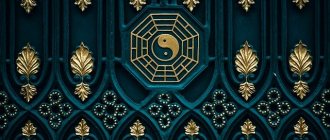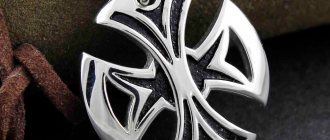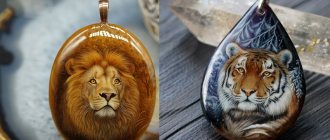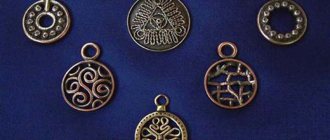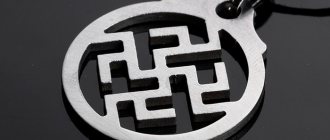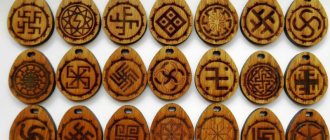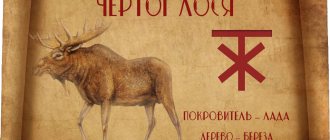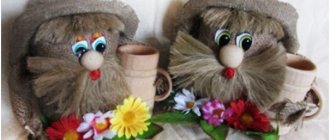Every nation has magical objects, the task of which is to both protect the owner from evil spirits, damage, envy, the evil eye, and to attract luck, prosperity and health. An example is Yakut amulets. The Yakuts honor traditions, preserve and pass them on to their children. Kharyskal (Yakut talismans) are an integral part of the culture. Ritual ornaments can be seen on clothes, hats and household items, as well as individual amulets.
A little from the history of ornament
This type of art has a long history, dating back to ancient times. However, due to a certain confusion in the general concept of folk ornament, the art of needlework in Yakutia remained invisible for a long time. It was not singled out as a separate type of folk art, in vain it was added to the folk ornament as a whole. And, of course, no one tried to study and decipher it. For the first time, the Yakut folk painter M. M. Nosov tried to find out the meaning of the Yakut ornament.
The artist was one of the first to generalize and identify several classifications of this drawing. According to his observations, the material used can be divided according to a number of characteristics. For example, he identified a certain chronological sequence.
The studied samples contained ornaments characteristic of the prehistoric era (ancient Yakut ornaments), elements of a religious nature, and images of social significance (carriages, harnesses). Drawings were present not only on body jewelry, but also on household items, dishes, and furniture.
Moreover, the Yakut ornament present on the objects under study was applied in completely different ways. For example, it was metal forging, chasing, engraving, embroidery, etc.
The path to the origins through acquaintance with the Yakut pattern ornament
Yakutia is the homeland for many. But in order to love it even more, you need to know the history and culture, traditions and peculiarities of life of the local population. If a people loses ties with the past, it loses its strength and loses its future. We must always remember this, because the traditions, spiritual and cultural values of our ancestors, their holidays and games, songs, fairy tales, family legends and rituals are moving further and further away from us. Ornament is a fine art of the people.
The purpose of my work: to get acquainted with the features of the national ornaments of the Sakha people through carpet weaving.
During the work, the following tasks were solved:
- Study literature on the topic of the project
- Find elements of the Yakut pattern in everyday life
- Create everyday objects using the carpet embroidery technique using Yakut patterns.
Hypothesis
If you know at least some of the Yakut patterns, you can learn to better understand the traditions of our ancestors, treat them with respect and care.
Research methods: survey, collection and analysis of information on the topic using various literary sources.
This school year we have added the subject “carpet weaving” to our schedule. At first it was not clear what this subject was and what one could learn. Irina Alekseevna answered all our questions and began to introduce us to a new type of activity, the creation of useful things for everyday life, made using the “carpet embroidery” technique. The art of carpet weaving has always been valued. Handmade carpets were of particular value. For our first small products, we began to select patterns. At first these were simple, not complex ornaments, then I learned that there are many types of Yakut ornaments.
I wondered: What kind of patterns are these? Where do the Yakuts use them? And what do my peers know about this? 20 people took part in the survey The survey results surprised me. Out of 20 people to the questions: “Can you “read” the Yakut ornament?”, “Do you know what the ornament means: circle, rhombus, hearts”?
“Yes” was answered by 2, “No” by 18. They answered the question a little better: “Do you know where a person uses Yakut patterns”? - “Yes” answered 5, “No” - 15. To the question “What objects, things with Yakut ornaments do you have at home?”, the guys named: choron, dishes, high fur boots, rug, clothes, jewelry. But no one was able to remember and sketch any Yakut pattern from memory. These survey results convinced me even more that I would definitely present my project to my classmates.
Having studied the literature on the topic of the project, I learned that the word “ornament” comes from the Latin word ornare - to decorate. Ornamentum - decoration in the form of a pattern.
Conclusions: The Yakut ornament not only decorates, but, according to the people, also has magical powers. This is both a talisman and hunting magic... While mastering the technique of carpet weaving, I learned about such types of Yakut ornaments as geometric and floral types. These include: linear ornament, ornament in the form of herbs, ornament in the form of oblique lines - wind, ornament in the form of the sky - herringbone, broken lines in the form of urasa, ornament in the form of a network, ornament in the form of a raspberry.
The Yakuts used and still use patterns to decorate clothes, dishes, household products, homes, and jewelry. As a girl, I am more interested in Yakut clothing, which is always elegant, even everyday clothing is decorated with a simple, uncomplicated pattern, and the craftswomen take special care in decorating festive clothing. They have their own Yakut style, which allows them to distinguish their products from those of other northern peoples.
Yakut ornaments are not only beautiful, but also have a certain magical protection.
Each color has its own meaning. For example, black symbolizes the earth, green - the plant world, red - warmth, sun, blue - space, lightness. An ornament that is laid out from rhombuses is called diamond-shaped, from triangles - jagged, from semi-ovals - nail-shaped. There are also heart-shaped, spear-shaped, finger-shaped and herringbone ornaments.
I learned that you can create a pattern from one type of ornament or by alternating two or three types.
As part of the project, I studied ways to create ornaments and showed creativity.
While working on the project, I learned that our region is preparing to host “Ysyakh Olonkho” in 2021 and guests will come to us from all over the republic. I believe that small souvenirs made using the carpet embroidery technique will be good memorable gifts.
Literature:
- Avramenkova, O.I., Dushatskaya, G. Ya. Hobby - carpet weaving/I. O. Avramenkova, - M.: Prospekt, 2006. - 48 p.
- Bardin “Folk crafts and souvenirs” Moscow, “Higher School”, 1990;
- Modern patterned weaving. N. S. Koroleva, L. A. Kozhevnikova, Light Industry Publishing House, Moscow, 1970
- Encyclopedia "Sewing and needlework". Scientific publication "Big Russian Encyclopedia", Moscow, 1999
- Scientific and methodological journal “School and Production”, No. 4–2002, No. 7–2005
- [email protected]
- www.intel.ru/education
How did other scientists and ethnographers classify the ornament?
After Nosov’s publications, other researchers and ethnographers became interested in Yakut national patterns and ornaments. They also examined these drawings and offered their own versions of their possible classification. Thus, the German ethnographer W. Johansen proposed to distinguish two main directions in Yakut art: spiral and geometric.
Another researcher and archaeologist A.I. Gogolev tried to divide art according to the existing stages of ethnic Yakut history. In his opinion, the ornament contained elements of folklore, ethnography, painting, archeology and history. At the same time, he actively compared the drawings of the peoples of Yakutia with the ornaments of other peoples. As a result, he was able to identify an interesting pattern.
It turns out that the Yakut ornament has several common features with the designs of other Turkic-speaking peoples. However, it does not have a meander motif like the Mongolian people. The material used and the method of applying the pattern also differ.
Yakut jewelry: Myths and traditions
Jewelry has always been an integral part of women's costume, Yakut women are no exception. This tradition has survived to this day - silver jewelry is worn not only on national holidays, but also on social occasions. YSIA talked with Anatoly Savvinov, a senior researcher at the Institute of Humanitarian Studies and Problems of Indigenous Peoples of the North SB RAS, about how to properly wear Yakut jewelry.
In ancient times, jewelry was made from copper, brass, and bronze. The Yakuts treated gold with disdain, believing that it was not much different from bronze; their favorite material for jewelry was silver, a pure and white metal. In addition to its practical value, jewelry served several other functions, the main ones being a talisman and a declaration of the social status of the owner.
According to the description made on the basis of material from ancient Yakut burials by ethnographer Mikhail Nosov , the complete set of jewelry of a Yakut woman included about eight items: head decorations - headpiece (bastynga), braid (cyhyox sime5e), earrings (ytar5a), neck and chest decorations - collar -necklace (mooi sime5e), necklace-hryvnia (kyldyy), chest and back decoration (ilin-kelin kebiher), wrist jewelry - wide bracelets (bɵ5ɵkh) and rings (bihileh). Also an integral part of the costume was a belt (chur). Belts were made of leather or fabric and decorated with silver plates with engraved patterns; sometimes belts were made entirely of silver. They were worn by both men and women; usually small things needed in the household were hung from such belts: wallets, key holders, tweezers, earwigs, needle cases, amulets. According to experts, a full women's dress made of silver could weigh up to 25 kilograms!
“In everyday life, jewelry was rarely worn. As a rule, age differentiation was observed: they were mainly worn by young women and brides. Older women wore a minimum of jewelry - earrings, rings, and with the advent of Christianity - crosses. A full set of jewelry was rarely worn, mainly on special occasions, such as a wedding. In addition, in the old days, jewelry was worn over a fur coat, since it was cast and very heavy. The tradition of wearing them over dresses appeared much later, when lighter forged jewelry began to be made,” says Anatoly Savvinov.
Headdress
The head - bastynga - is a leather or metal hoop to which long chain pendants are attached on both sides, framing the face. Some bastyngas also have one or two cross bars that make them look like a helmet. Today you can find different opinions about who was supposed to wear the bastyng - some believe that it was a girl’s headdress, others are of the opinion that it was worn mainly by married women. Anatoly Savvinov , who studied a lot of materials from Yakut burials, claims that the bastynga is a girl’s headdress.
“In the old days, bastyngs were made of leather or fabric. There were different types of headbands - decorated with beads, embroidered with silk threads, braid, etc. The metal version is a modern innovation; they didn’t do this in the old days. One of the options was used for attaching back decorations - kelin kebiһer. As an independent decoration, the bastyng is rarely found in archaeological materials, so it is a stretch to say that it was a separate part of the attire. It was mainly worn by girls - married women were not allowed to bare their heads or show their hair. Therefore, they always wore a thin cap or scarf. The bastyng was worn under a hat - jabaka, and a metal circle, which today is placed in the center of the hoop, was attached to the top of the hat,” he says.
Chest decorations
An obligatory part of women's clothing was a chest and back set of jewelry - ilin-kelin kebiher. In summer it was worn over a khaladai dress, in winter - over a fur coat.
The attire indicated the social status and financial position of the woman; the higher this position was, the richer the decorations were. The first row of ilin kebiher consists, as a rule, of three elements - chains. It is believed that they symbolize the three parts of the human soul. This is followed by a flat trapezoidal plate, to which long chains with pendants are attached. For married women, a round kun element was placed in the center of the ilin-kebiher, symbolizing the sun.
The second part of the decoration - kelin kebiher - is worn on the back; it balanced the heavy front part and prevented the woman’s neck from getting tired. Today, when jewelry has become lighter, this part of the dress is often omitted. Like other jewelry, ilin-kelin kebiher was intended to protect its owner from the influence of evil spirits - abaasy and to attract wealth, fertility and health to her.
Earrings
Earrings - ytar5a have been worn since ancient times. But today the most widespread are earrings with pendants. They consist of two parts: the upper part - iemeh, which is threaded into the ear, and the pendant - tugeh, which is attached to the iemeh. Chohu earrings are also known; they were made in the form of a curved oval metal plate and were worn without pendants.
The pendants had a variety of appearances and, like the elements of bastyng and ilin-kelin kebiher, carried information about the status and financial situation of their owner. The most luxurious pendants were worn by rich women. Representatives of the poor classes were content with more modest options. The traditional type of pendants were Christmas trees, expanding towards the bottom.
As Anatoly Savvinov , such earrings became widespread in the 19th century, when the active development of trade began.
“The most ancient earrings are those with pendants made of beads; this type is considered the earliest. In the 19th century, large earrings with pendants became widespread. Depending on the technique, there are both cast and forged. Chohu is a later type of earrings; most likely, they were borrowed from other peoples. In general, with the development of trade and the advent of textiles, many borrowings appeared in Yakut attire, including the khaladai and men’s caftan,” he says.
Today, it is pleasant to consider earrings with pendants in the form of a lyre as a classic version of Yakut earrings. This form has several symbolic meanings at once - cattle, sardana flower, bird, female figure. Women of childbearing age wore pendants with a small droplet-shaped element loosely attached inside; some sources claim that it symbolized the baby in the womb. When a woman grew old, she could pass the pendants on to her daughters or granddaughters, but the upper part—iemekh—remained with her until the end of her life. However, according to Savvinov, this is nothing more than a fantasy of modern stylists.
“Yes, there is an opinion that the earrings indicated the number of children and a woman’s figure. But this is not true, a modern fiction. There is no mention of this in the available archival and archaeological materials. The same can be said about ornaments. But it’s true that earrings and other jewelry were passed down from generation to generation. In old age, as a rule, they were not worn; it was considered indecent to dress oneself up abundantly,” says the scientist, adding that today it is very difficult to find authentic national jewelry in Yakut museums. This is due to the fact that when the museum boom began in Russia at the end of the 19th and beginning of the 20th centuries, numerous expeditions of collectors of antiquities came to the regions of Yakutia and took finds with them.
“Now their finds are kept mainly in central museums and abroad - there you can see real Yakut jewelry. Our museums hold a very small part,” he says.
Bracelets and rings
Hands were decorated with paired silver bracelets and rings. Flat bracelets, approximately 5-7 centimeters wide, were decorated with rich engraving and worn over the dress. Along with bastynga and ilin-kelin kebiher, bracelets were part of the festive decoration, in contrast to earrings and rings, which were worn every day.
Tradition and modernity
Of course, today national jewelry has partially lost its sacred meaning - when choosing earrings or a ring for themselves, people are guided not by the meaning it carries, but solely by their taste and preferences.
In addition to jewelry of traditional forms, jewelers are creating more and more new options: today in store windows you can see silver earrings and pendants in the shape of a horse saddle cloth, Yakut khomus, sardana flower, choron, deer, and Siberian Crane. Even if you don’t find what you want among this variety, you can draw your sketch and the master jewelers will make jewelry in accordance with your wishes.
Our interlocutor was skeptical about modern trends. In his opinion, when choosing clothing, it is necessary to follow certain rules. In particular, decorations must be made in accordance with traditional canons. He also does not welcome a hobby for a large number of decorations.
“It’s good that today culture is being revived, traditional silver jewelry is being worn. But their choice must be taken very carefully. I don’t like metal bastyngs - they weren’t in the tradition. Not the best option - rings the entire length of the finger - I don’t know where they came from. This is probably the spirit of the times, but you need to be careful with such decorations,” he says.
During this time, the traditions of jewelry also changed - jewelers began to actively use gold to make jewelry in the national style, silver jewelry became less massive - they became light and delicate. This is not least due to economic considerations - such products require less metal, which means they are more affordable. Jewelers also began to use precious and semi-precious stones and, of course, diamonds in their work - even silver jewelry with such inserts looks very impressive.
Traditional jewelry does not lose its popularity: men's and women's silver belts, bracelets, bastynga are not at all uncommon in stores and are in constant demand. Those who cannot afford to buy a full set of chest decorations can limit themselves to only ilin cabiher. And yet, despite the rather high price (a 4-5 kg silver piece can cost from 25 to 60 thousand), many try to collect the entire set of jewelry in order to then pass it on to their children and grandchildren.
Classification of ornament according to the traditional principle
There were ethnographers who classified the Yakut ornament according to the traditional principle. During the study, they identified two groups of patterns: floral and geometric. Over time, zoomorphic (with images of representatives of the animal world), anthropomorphic (with drawings of humans), and ornithomorphic (with symbols of birds) were added to this classification.
However, many ethnographers believe that the thematic patterns themselves are often difficult to read. This is especially true for people who are encountering the meaning of the Yakut ornament for the first time. In addition, often the image of animals is closely intertwined with floral or geometric patterns, which greatly worsens the overall perception of the drawing. This further confuses and complicates the interpretation of such a pattern.
Presence of animal traces in the ornament
In the ornamental paintings of the peoples of Yakutia, drawings imitating animal tracks are often used. For example, on some interior items you can find traces of a moose, bear, mouse, duck and other representatives of the animal world. Many researchers suggest that this image is directly related to folk beliefs of the so-called hunting magic. It is characterized by the veneration of animal tracks.
What types of Yakut ornaments are there?
There are many different interpretations and classifications of the types of ornaments of the people of Yakutia. However, among the numerous versions, the geometric appearance of the design is distinguished. As a rule, it contains various geometric shapes arranged in a certain sequence. Moreover, such motives can be simple and complex. Simple ones include a skillful combination of lines. They can be long, short, single or double.
These types of Yakut ornaments are used in wood carving, in the process of engraving and bead embroidery. It is noteworthy that a wide variety of materials are used to apply such lines. For example, wood, cloth, birch bark, silver, bone.
Straight lines serve as both the main and transitional patterns. They smoothly connect one or more elements with different patterns.
Symbols and ornaments
In order to protect the owner from evil spirits, embroidery was applied to clothes in vulnerable areas of the body that could be exploited by evil spirits:
- sleeves;
- collar;
- belt;
- bottom of the robe;
- back.
Most often, plant patterns that represent development and fertility are used for these purposes. Before applying patterns, you must know their meaning:
- The ornament should always rise, but not fall.
- The sprout of a plant is interpreted as the beginning of life, that is, the appearance of children.
- Buds are embroidered for teenagers.
- Blooming flowers - young people.
- The lyre-shaped pattern cannot be applied to objects and clothes of girls or elderly women.
But Kharyskhal was also performed in the form:
- Pisces - prosperity and prosperity.
- The tree of life is the spiritual and creative energy of the people.
- Stork is a talisman of female happiness. Symbolizes fidelity, continuation of the family.
- Lyre shape - fertility and development.
- The outlines of birch leaves are purity.
- A horse or deer - forward movement, rebirth, constant renewal in nature.
- Geometric shapes that signified natural elements. Thus, the circle symbolized the sun, and the signs inside were interpreted as a connection with the outside world.
According to customs, men's clothing was decorated with five rhombuses connected into one. This was a sign of impeccability, as well as the fusion of the five elements: fire, wood, water, air and metal. In the middle of the rhombus there was a circle embroidered, which meant the feminine principle. Such a complex ornament symbolizes the fact that there is an inseparable connection between a man and a woman.
You can also find a motif with three divisions, reminiscent of the yin-yang symbol. It stands for three souls: mother, earth, air.
Application of zigzags in folk art
The so-called zigzags also look great in patterns. These elements are easy to find on jewelry, wooden and metal household items, and in interior design. For example, zigzags are used to decorate decorative doorways and partitions called khapakhchi. They also take an active part in masking the seams and joints that arise in the process of creating an ornament.
These elements are used to create a talisman called kharyskhal. Yakut ornaments in this case will carry not only aesthetic beauty, but also a certain magical protection. It is believed that such a talisman can protect children and your family from the negative influence of otherworldly forces. It brings good luck and saves from the evil eye, misfortune and bad luck.
Types of talismans among the Yakuts
The Yakuts call their protective symbols kharyskhal. This word literally means “one who protects.” Each family had its own kharyskhal. Yakut amulets, talismans and amulets are very diverse. With their help, you can protect only family members, home and livestock.
Almost all talismans used by the Yakuts are natural. These people greatly respect the forces of nature and respect them. Anything people find while hunting or gathering is used as protection. The most common Yakut amulets:
- parts of hunted animals - fangs and claws, amulets in the form of skins were often found;
- stones of unusual shape or color;
- wooden figurines;
- amulets made of precious metals - silver or gold.
Patterns for amulets
Women often created amulets at home, embroidering on fabric with beads or threads. According to legend, everything that a woman made with her own hands was considered a talisman for the home. This also applied to embroidery. All objects with magical properties could reflect negativity and protect the family from damage and the evil eye.
A few words about other geometric motifs
In the drawings of the Yakut people, simple elements are often found, for example, circles, rectangles and squares. With their help, artisans and craftsmen create beautiful belts. In addition to the circle, the ornament contains the image of dots. According to experts, folk craftsmen borrowed these elements from the artisans of Ancient Egypt. From there came the interpretation of this tandem (circle and dots), associated with divinity and the sun. The circle is also considered an excellent amulet and a symbol of fiery power.
Most often, circles with dots can be seen on a wide variety of products made of wood, leather, ivory, silver, clay, and birch bark. Circles of different diameters are present on elements and details of clothing: hats, outerwear, belts, robes.
The face of nature is a muse for Yakut jewelers
What is a muse for a master? This is the face that awakens creative inspiration. And for Yakut master jewelers it is a beautiful face of nature.
In the cultural history of the Sakha people, jewelry occupies a special place of honor. Like other peoples, the Sakha people developed jewelry from blacksmithing. Blacksmiths enjoyed universal respect and in their power were equated with white shamans. The main material for the manufacture of Yakut jewelry was silver.
The study of women's jewelry leads to the conclusion that, in addition to its utilitarian value, they were obligatory as a talisman and were symbols of wealth, distinctive signs of the clan.
Jewelry is an integral part of a woman's image at all times.
They say that previously a complete set of jewelry for an unmarried Yakut beauty weighed no less than a pound (that is, more than sixteen kilograms)!
The set included: ear, braid, neck-chest, waist, wrist jewelry.
And nowadays, talented master jewelers of Yakutia continue to delight and surprise with their impeccable craftsmanship, based on centuries-old traditions and keeping pace with global trends.
Unlike the old days, everyone can now treat themselves to jewelry. For the discerning taste of the modern fashionista, authentic jewelry is now at a premium, not just precious metal! Let's consider modern jewelry models and the meaning of original patterns.
Yakut jewelry is richly decorated with a variety of lyre-shaped patterns, in which the curves of the female body, sardana petals, tree branches, and snowdrop inflorescences can be read. The proud, handsome deer and the divine Siberian Crane birds can be embodied in fancy patterns.
The spirit of nature is clearly present in the works of Yakut masters and has a deep sacred meaning:
The lyre-shaped pattern is a floral pattern that symbolizes fertility (this pattern is also interpreted as a symbolic image of a cow) and development.
A plant ornament in the form of a sprout is suitable for a little girl, and for a slightly older girl - an ornament in the form of a bud . A person is like a flower: first a sprout, then a bud, and finally a flower .
of the Sardaana flower is inspiring with its beauty and fiery coloring . According to Sakha legends, when the brightly fiery Sardaan lily blooms in early May, the goddess Ieyiehsit descends to earth and brings summer with her. Ieyiehsit patronized the lucky ones, filling their lives with health and blessings. And returning to heaven, this goddess conveyed to the supreme gods the requests of those whom she especially patronized.
Especially valuable for women are jewelry with dancing Siberian Cranes , which are designed to protect women's happiness. Such jewelry brings harmony, longevity, and wisdom. Do you know that Siberian Cranes are monogamous and show us an example of loyalty and devotion?
Proud handsome . The deer is an auspicious symbol associated with the Sun, sunrise, light, purity, renewal, rebirth, creation and spirituality. Due to the resemblance of deer antlers to branches, the image of a deer is associated with the Tree of Life.
The horse is a symbol of life, optimism, diversity of feelings and perpetual motion. The horse carries the wind of change and strength.
The Tree of Life is a sacred tree. In the spring, next to the sacred trees, rituals were held dedicated to the spirit-mistress of the earth: the tree was decorated with ribbons and sprinkled with kumys, while asking the spirit-mistress of the area, as well as other good deities of the pagan pantheon, to send wealth and prosperity.
The eagle in Yakut mythology is considered the son of a heavenly deity, the head of all birds. They believed that the eagle brought fire to people, and they revered it as the owner of fire. When the eagle flew to Yakutia in the spring, winter was receding.
Pisces is a sign of wealth and prosperity!
Earrings with rustling pendants - carved birch leaves - are not only beautiful in themselves, they also contain hidden well-wishes for the newlyweds.
Snowdrops are a symbol of spring and awakening after a long winter.
Snowflakes, frosty patterns, northern lights are the leitmotif and endless source of inspiration of the Siberian master.
Also in the ornaments there are many totemic patterns of geometric shapes - rhombuses, crosses, squares, waves, spirals and the like. The fusion of geometric and floral patterns contributed to the development of a variety of works of jewelry.
The current boho-chic look can be considered complete, you just need to add authentic Yakut jewelry.
Do not hesitate, it is not only fashionable and original, but will also serve as a talisman for you!
Why is the human figure not realistic?
In addition to geometric images, the ethnic ornament of the people of Yakutia sometimes contains images or human figures. However, they are far from depicting real people. The reason for this sketchiness is directly related to the Yakuts’ belief in spirits. Such prejudices slightly hampered the development and modernization of the human figure.
Later it became more clear and elegant. Ornaments with human figures are widespread on textiles, wood, and bone. They were also depicted on the front of the saddle, where mostly women sat.
Even later, human figures (in the form of a shaman playing a tambourine) were depicted on kumis bowls. The outlines of a clear female figure can be seen in Yakut embroidery. Such a figure signified fertility, femininity and was a talisman of the family hearth.
LiveInternetLiveInternet
Quote from Thumbelina13
Read in full In your quotation book or community!
Yakut amulets: the meaning of ornaments
The people of Yakutia number almost half a million people. They live on the territory of the Republic of Sakha, in the Irkutsk and Magadan regions, Khabarovsk and Krasnoyarsk territories. These people still honor traditions, preserve them and pass them on to their descendants. A large part of culture is occupied by talismans: details of the national costume, hats, jewelry, and household items. The meaning of Yakut amulets and their types will be discussed.
What are they, Yakut amulets
The Yakuts are close to nature, they live in harmony with it, obey its laws, and treat the power of the elements with awe and respect. Almost all talismans used by the Yakuts are made from natural materials. These include:
- bones, fangs, claws and animal skins;
- silver jewelry;
- wooden miniatures of household items;
- stones;
- ornaments embroidered with beads or thread.
Magical objects protected from the evil eye, damage, spirits, from the influence of the elements, preserved health, and attracted good luck.
Ornaments are applied to Yakut clothing to protect against evil forces, so embroidery is used to decorate the weakest places through which spirits can penetrate: the hem, sleeves, collar, belt, spine.
The main motifs are plant-based, suitable for everyone, symbolizing development and fertility. When choosing a pattern, you need to consider the following features:
- the lyre-shaped pattern is not suitable for girls and grandmothers;
- a plant sprout for small children, a bud for older boys and girls, blossoming flowers for older ones;
- the ornament should have tended upward, not downward.
Men's clothing was traditionally decorated with five rhombuses combined into one. This is a symbol of perfection, a combination of five elements: water, air, wood, fire, metal. In the center of the rhombus, the circle is the feminine principle, since the man is inseparable from the woman.
Another traditional motif resembles yin-yang, but with three divisions. It symbolizes three souls: mother, earth, air.
Metal items were put on or amulets were sewn onto the locations of the main chakras. This is the solar plexus, forehead, hips, belt, heart area. For example, from the inside out, opposite the heart, the face of a small animal was hemmed. On the caps, a metal plate was placed in the center of the forehead.
Talismans were originally made from any metal; blacksmiths did this. They were revered on a par with shamans. Rich families had their own personal master.
Later they began to be made exclusively from silver; gold was not used. Silver has cleansing powers and drives away spirits.
Wedding attire stands out especially since the bride is the successor of the family, and the well-being of the family and the health of the children depend on her. Every detail mattered. Most of them drove away evil spirits and the evil eye, the other side was aimed at strengthening reproductive function.
A wedding suit consists of the following fragments:
- headdress;
- earrings;
- chest set;
- back set;
- bracelets.
The weight of the decoration could reach tens of kilograms. The dowry was prepared from the very birth of the daughter, making one piece of costume per year. By the age of majority, a full dress had accumulated.
Everyday items were more modest. The main types include:
- Earrings. They started wearing them at the age of five. The shape of the earrings resembled the figure of a girl, and the details were a message to others, informing others about the status of their owner. For example, girls wore flat, one-piece figures. A hole in the center indicated married status. Earrings in the shape of a lyre with pendants were worn by women with many children. An aging woman takes off her pendants and gives them to her granddaughter as a sign of continuation of the family line.
- Bracelets. In addition to protective functions, they have a practical one. They fasten the sleeves of clothes with bracelets to keep out the cold.
- Belt. He did not allow spirits to penetrate the body, so only shamans could walk without belts. Adults richly embroidered their belts with ornaments, and children girded themselves with rope.
Men, women and children used different talismans because their social functions differed.
Amulets for children
It is customary to protect a child even before birth. The moment of birth is especially dangerous, when evil spirits can harm the baby and mother, so the birth was accompanied by numerous talismans that preserve the life of the baby and alleviate the suffering of the mother.
The patroness of fertility, protecting the woman in labor - Aiyysyt. She was symbolized by the skin of a hare. Threads of beads were threaded through the eye sockets, and earrings were put into the ears. During childbirth, the skin was generously oiled.
Earrings, a bit, and a whip were hung over the bed of a woman in labor to reduce pain and for a successful outcome. A circle was drawn around the bed with a birch stick, since the birch tree contains the spirit of the mistress of the area; not a single representative of the other world could cross such a line.
After the baby was born, a knife was stuck into the stick that the woman was holding on to if a boy was born, or scissors if a girl was born.
In the first year of life, a baby cannot yet resist evil on his own, so he is hunted by the soul eaters of Abaasyt. They were driven away by tying a knife in a sheath, a flint, a hatchet, a bear's paw, and a sable skull to the sides of the crib.
Rings, metal plates and other ringing objects were sewn onto the blanket. A child who began to crawl and walk had a bell tied to his back. By ringing, he cleared the room of bad energy, scared away spirits and told the mother where the baby was.
For a good night's sleep, a hare's foot was sewn into the corner of the pillow.
From infancy until the end of his life, a person kept a bag made of taimen leather “Ogo kuta”. It contained 10 umbilical cord bundles and hair. This is the concentration of life force.
Grown-up children wore earrings, pendants, and metal plaques with designs and beads. A traditional amulet for a boy is a bow and arrow. This is the concentration of masculinity, the moral and physical qualities of the future man.
Women's mascots
They are aimed at maintaining health, strengthening the family, and developing intuition.
To facilitate breastfeeding, a smooth stone with a funnel-shaped hole in the center is used. It was customary to express milk through it.
A girl setting off on a journey made an amulet with her own hands from bear fur, reminiscent of a brush - moonnyoh. It was hung around a horse's neck to clear the way for spirits.
A girl of great age made a whip from willow branches, decorating it with figurines made of bone and silver. A bell was hung from the tip of the rod. After the baby was born, the whip was hung over the cradle.
A silver plaque, tuosakhta, symbolizing the sun, was worn on the caps. One of its meanings is protection against smallpox.
Girls wore earrings, rings and bracelets as jewelry. When walking, the decoration should jingle so that evil does not approach.
In addition to the hat, the protective headdress of the bastyng is a hoop. The plaques on it covered vulnerable parts: the forehead and temples.
Men's amulets
Men wore almost no jewelry. Embroidery and animal parts were used as talismans: heads, paws, claws, teeth, bones. It was believed that the qualities of a killed animal were transferred to the hunter who killed it. In addition, the Yakuts chose a totem animal for themselves. They associated themselves with him, adopting properties, and were protected.
Animal mascots helped to track and kill prey while hunting, while remaining invulnerable. The fur of a wolf or bear was considered a talisman against the evil eye and disease.
Another animal amulet is a necklace of noses. This part of the animal’s body had a soul, so the Yakuts collected the noses of small animals in bundles: sables, arctic foxes, foxes to attract good luck.
For a successful hunt, a talisman made from the skin, horn and jaw of a deer was used. This bundle contains the spirit of the patron of animals and hunting.
The most powerful talisman is the Sata stone. It was found in places where lightning struck, and it also originated spontaneously inside a horse, bull, bear, dog or wolf. They recognize him by his appearance. Sata resembles a miniature human head, where eyes, nose, mouth, and ears are visible. This stone is alive. To prevent the stone from dying, a girl should not touch it, a stranger should not look at it, and the stone should not remain naked. It was customary to keep the amulet wrapped in the fur of the animal that gave birth to it away from home. With the help of sat, the Yakuts changed the weather or tied them to a horse during travel so that it would not sweat and would not be bothered by gadflies.
Modern amulets in Yakutia
Research shows that most Yakuts believe in the power of amulets and many keep them at home. True, many of them are a thing of the past. The most common:
- dishes and household utensils with ornaments;
- embroidery on national clothes;
- drawings of animals;
- bear paws;
- precious items.
The last type of amulet is especially interesting. The motifs remain the same: lyre, female figure, floral ornament. But jewelry has become refined, openwork and not so massive. Silver is being replaced by gold and precious stones.
Experts warn that there are many Chinese counterfeits of Yakut products on the market. They are cheaper, but do not carry spiritual value or protective meaning. After a few generations they will lose their beauty and value. It is better to give preference to traditional Yakut craftsmen who are familiar with the history, culture and traditions of the people.
https://proamuleti.ru/oberegi-jakutskie.html
Mythical motifs in art
Among the most famous mythical characters who smoothly migrated from Greece to Yakutia was the centaur. His figure could be seen on various metal jewelry, dishes, decorative items, and vases. But, according to experts, this element has not taken root very well. That's why it wasn't used too often.
The situation is completely different with the depiction of real and mythical birds. They symbolize freedom, joy, the elimination of all barriers and boundaries. The most popular design is, of course, the eagle. He is considered the patron saint of hunters and a kind of male talisman.
The second most popular bird that Yakut craftsmen included in their ornaments is the raven. It is a totem of strength, wisdom and endurance. The swan was considered a symbol of innocence and purity. He brought happiness to the house.
Images of plants in drawings
Floral and plant patterns have also become an integral part of the folk art of Yakutia. In various variations you can find a beautiful curly stem, reminiscent of a loach or wild ivy. Stems, leaves, buds and flowers may arise from this stem. Such plant motifs are easy to notice on silver items, dishes, belts, hats, saddles, and shoes.
Among the varieties of floral patterns, you can actually find motifs of fruits, berries and herbs. In the drawings there are also trees with a large and spreading crown.
Rows, Columns and Repeats
In folk art there are not only lonely compositions depicting dotted motifs. Usually the drawings are closely intertwined with each other. Creating a harmonious completeness of the ornament can be achieved by repeating patterns and correctly distributing them into rows and columns. And, of course, such patterns look complete. They are spectacular and immediately catch your eye with their impeccability.
As you can see, ornament is an entertaining form of art, lectures about which can be included in the curriculum of a secondary school and technical technology. Yakut folk ornaments made of metal, wood and clay are interesting not only for adults, but also for children.
